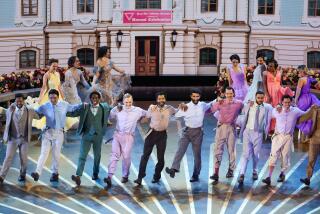IN THE FOOTSTEPS OF A KATHAK MASTER
- Share via
Sitting cross-legged, an embroidered shawl spread across his knees, Kathak dance master Pandit Sundarlalji Gangani raises his arms expressively, his face assuming the look of longing and sorrow:
“The whole night has passed, and Krishna has not come back to his lover Radha,” he sings in a colloquial language that’s a combination of Hindi and Sanskrit. “The peacocks are calling, and yet he has not come. She misses him. She is scared about his absence.”
Translating what Gangani sings is Anjani Ambegaokar, a Los Angeles-based Kathak dancer who studied with him for 15 years and who will be performing several of his works at the second annual Kathak Dance Festival, 7 tonight at the Anaheim Marriott hotel.
Also performing on the program are dancer Sitara Devi and tabla player Ustad Zakir Hussain, plus 53 of Ambegaokar’s students. Gangani will conduct the program.
“Lots of people think Kathak is just a lot of footwork,” says Ambegaokar. “They don’t know how important expression is, too.
“The masters, like Gangani, don’t even need makeup or costumes. What they can do just sitting there is incredible.”
Gangani, 57, is descended from a family of artists and Kathak performers. “It is like an industry of dancers,” he laughs.
For the last 35 years, he has taught at the Maharaja Sayajarao University of Baroda, India, and although once active as a performer, he no longer dances.
“He feels that there is an age after which one shouldn’t perform,” Ambegaokar translates.
But he continues to choreograph and write poems and songs.
Two works on the program were created especially for Ambegaokar’s students: “Kathak Katha,” which describes how the style started and illustrates its techniques, and “Goverdhan--Leela,” a dance drama that retells the legend of the god Krishna lifting a mountain to protect villagers from the anger of the god Indra.
Creating Kathak dances for groups is controversial, however.
“The traditionalists say that Kathak is a solo art form,” Ambegaokar explains. “Guruji (Gangani) feels that as an individual artist he reaches an achievement which is a lot superior to a group presentation, which is more of a show and maybe loses some of the artistic heights.”
But as a teacher, Ambegaokar defends the practice: “To be able to train in India, a solo artist takes many years. We don’t have that time here,” she says.
Ambegaokar’s own studies with Gangani began when she was a child.
“I started learning Bharata Natyam (the classical Indian dance form) when I was 3,” she says. “But I was not that fond of dance.
“Then Guruji came along when I was 7. He’s a great teacher with kids. He created my interest in Kathak. The rhythmic part is very catchy for a child. And then I liked the stories.”
Kathak is characterized by breath-taking spins and flashy rhythmic footwork, which is emphasized by the five pounds of brass bells the dancer wears around each ankle. Subjects of the dances include ancient stories drawn from Hindu mythology and poetry.
One of the key elements in Kathak is spontaneity, Ambegaokar says. “But spontaneity only comes after many, many years of training. Guruji always told me that first the rhythm of the dance should flow in your blood before you can attempt any spontaneity.”
Like most serious dancers, Ambegaokar continues to study with her guru, traveling back to India yearly or taking advantage of a few hours during this, his first visit to the United States.
“It feels good to be a humble student again,” she says.
“He brings you right back to the ground. You feel that he’s always 2,000 steps beyond you. There is so much to learn. It is the ocean.”
More to Read
The biggest entertainment stories
Get our big stories about Hollywood, film, television, music, arts, culture and more right in your inbox as soon as they publish.
You may occasionally receive promotional content from the Los Angeles Times.










